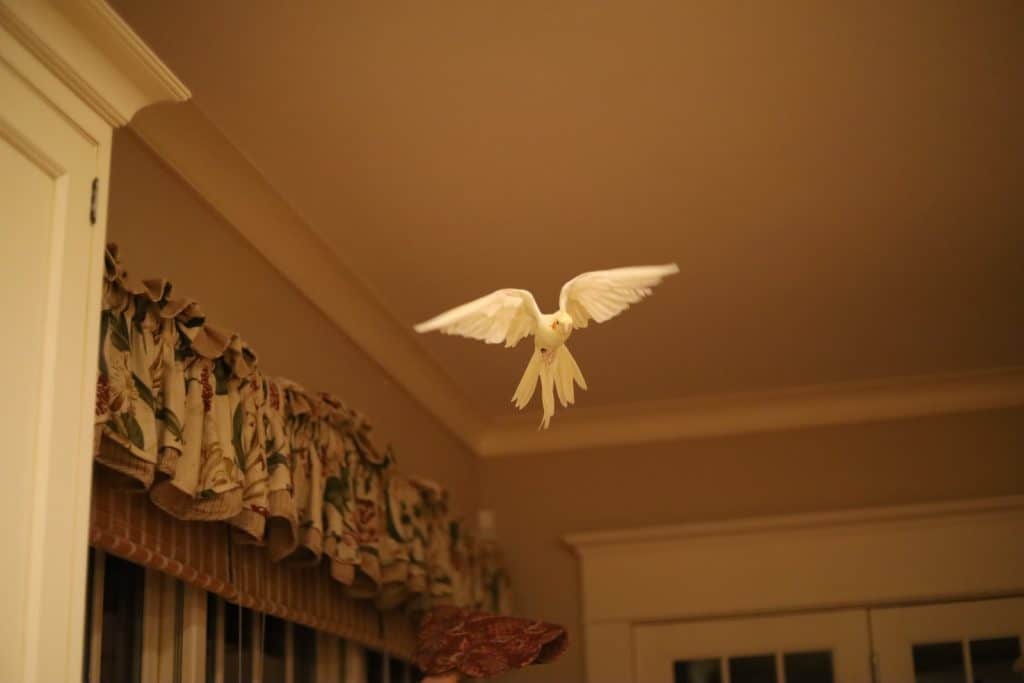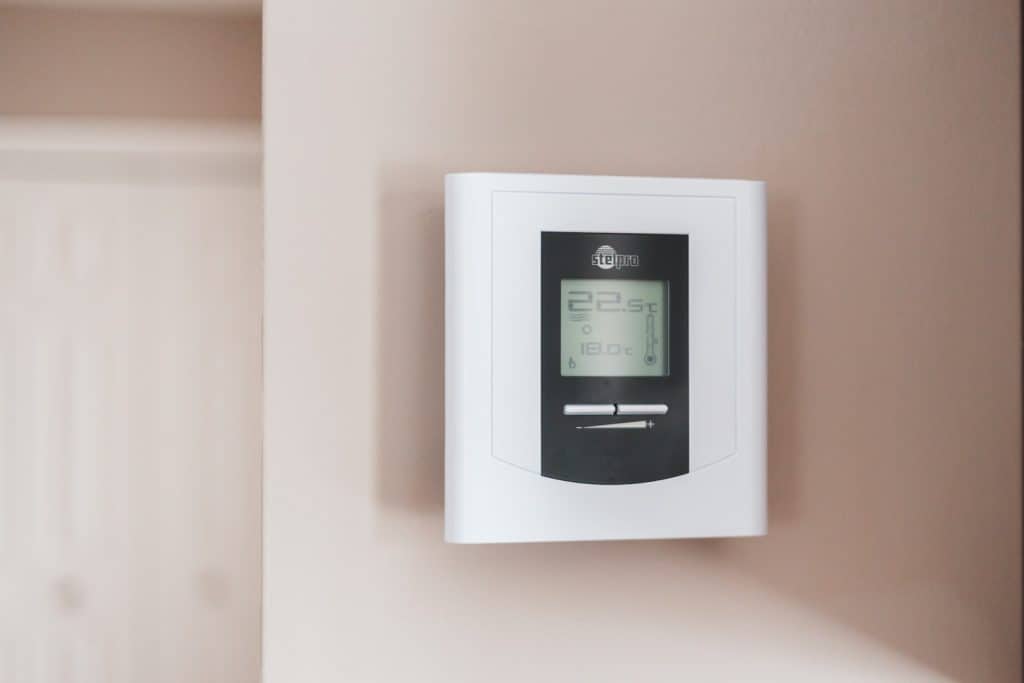Depending on your location, springtime might bring warmer weather or cooler temperatures. But do you know what is the temperature for cockatiels? And how can you tell if they’re too cold or hot?
When the weather outside is cooler than they like or if there are big temperature changes, both parakeets and cockatiels are hardy birds but can get chilly. To keep your pet bird comfortable, maintain a room temperature of around 70 degrees.

What Is the Ideal Room Temperature for Cockatiels?
The Puffball
When your bird fluffs up his feathers, he may appear chilly. He might look like a tiny downy ball. Next to the skin of a cockatiel or parakeet, his feathers are puffed out in order to trap pockets of warm air. When resting at night, cockatiels and parakeets puff their feathers to keep them from sticking together — so it’s difficult to determine whether they’re cold or sleeping. If your bird appears puffy during the day, make sure he’s not in a draft and that the room isn’t too chilly.
Other Signs
If you notice your bird tucking his head down and into his chest or shivering, he may be cold. Additionally, parakeets and cockatiels usually sleep on one foot with the other curled up underneath them. If your bird looks like he’s sleeping on both feet with feathers puffed up, he’s likely cold. On the contrary, a cockatiel or parakeet who is comfortable will tuck his head into a wing to sleep. However, if he’s huddling in a corner of the cockatiel’s cage floor , this could signify that he’s chilly .
A Bird’s Metabolism
Parakeets and cockatiels have greater body temperatures than humans. Their usual body temperatures are between 102 and 112 degrees Fahrenheit, which they drop when the room temperature drops or the weather becomes chilly. To keep his internal temperature steady, a pet bird must work. You’ll notice that your bird eats more as the weather gets colder. That is why birds molt in the summer when it’s hotter.
Birdie, It’s Cold Outside
Although you might not feel the cold weather in your home, your pet bird can. If you keep its cage near a window, make sure to move it on cold or windy days. A fall chill can lead to illness for birds, so pay attention to outdoor temperature changes and ensure their quarters are cozy.
Temperature for Cockatiels: Do Cockatiels Get Cold?
Cockatiels are built for warm weather and become stressed in cooler temperatures below 40 degrees Fahrenheit. Left unchecked, they can die from the cold as hypothermia sets in.
Birds with brightly colored feathers, such as parrots, usually come from hot or tropical climates. Cockatiels originated in Australia and are often found in the country’s wetlands, scrublands, and bushland. These birds are very popular petsin America and Europe.
If you have a cockatiel, or are thinking about getting one, you may be wondering how they do in colder weather. The honest answer is not well- so as the owner, it’s your job to make sure cockatiel warm all winter long.
Cockatiels generally don’t do well in extremely cold or hot climates; moderate temperatures are best for them. That being said, they can endure colder weather and still be alright as long as it’s not too far below freezing. Night-time temperature around 40 degrees Fahrenheit is the maximum they can handle before things get too uncomfortable for them.
It’s quite possible that your cockatiel is suffering from hypothermia. Cold temperatures can be fatal to a cockatiel if they are exposed to them for an extended period of time. You may assist your cockatiel to withstand colder temperatures by enhancing their living conditions and ensuring that they are kept warm at all times as the owner.
Taking them outside to spend some time in cooler conditions is another option. nYou may start by letting them (of course) out for a few hours each day in the early fall to help them build their resistance gradually to the cold.
Always keep an eye on your pet, especially when they are outdoors. If you notice any unusual behaviors or think something might be wrong, take them inside immediately. It’s also important to not leave them outside for too long; especially in the beginning. Help them acclimate to their new surroundings by gradually increasing the amount of time they spend outdoors.
Ensure that your cockatiel is not outdoors in harsh weather conditions like rain or strong winds, as these could hurt him. If you slowly introduce him to spending time outside throughout fall though, he’ll be more resistant to cold temperatures by the time winter comesrolls around. Always keep an eye on him when he’s outdoors during colder months, and if he appears uncomfortable at any point, bring him back inside immediately.]
Signs To Watch Out For
Sneezing
If your cockatiel is sneezing excessively, this should be an immediate warning sign to you that your bird may be sick or otherwise in poor health.
Weight Loss
It’s a pity that most bird owners don’t bother to check their pet’s weight, especially for creatures like cockatiels who have smaller fat reserves than larger birds (learn more about monitoring your bird’s weight).
Feather Fluffing
Birds of all kinds, including cockatiels and parakeets, will sometimes fluff up their feathers to show that they’re either content or seeking warmth. Because it can mean different things depending on the context, it can be difficult to tell what your bird is trying to communicate (read more about cockatiel behavior). However, if they keep their feathers consistently fluffed up throughout the day for extended periods of time, this usually indicates that they are feeling cold or sick.
Closed Eyes
A healthy cockatiel will have widely open eyes. If their eyes are only half-open when awake, it means they might be cold or ill. They will close their eyes when petted, which means they are relaxed (find out more about signs of illness in cockatiels). Otherwise, not closing their eyes is a bad sign.
Excessive Sleep
Just like with people, when animals sleep too much it is often a sign of poor health or that they are not well-adjusted to their surroundings.
Discharge
If your wild cockatiel is suddenly cold, check for any discharge or wetness around its nose. Follow this by looking to see if the bird is regurgitating its food more often than usual (discover more about cockatiel care). While this behavior can also be a sign of courtship, it’s always better to be safe and consult a vet.
Temperature for Cockatiels: Can Cockatiels Live In The Cold?
Yes, cockatiels can survive in the cold as long as they are not subjected to extreme cold below 40 degrees Fahrenheit. As previously said, it’s best to start off by gradually exposing your birds to low temperatures throughout the fall.
If you reside in an area with harsh winters, ensure your cockatiel is kept indoors where it’s warm at all times. They’ll require more calories during winter to maintain their energy levels; however, beware of overfeeding them (check out tips for keeping cockatiels warm). They keep themselves warm by pressing themselves against their body heat. You can also use a heat lamp when their temperature drops.
Temperature for Cockatiels: What Temperature Is Too Hot For Cockatiels?
The ideal temperature for a cockatiel body temperature is between 70 and 75 degrees Fahrenheit. If the temperature rises above 85 degrees, your cockatiel will become uncomfortable, and it is at risk of overheating. Although cockatiels can survive temperatures up to 104 degrees Fahrenheit or slightly above, this is harmful. It may raise the danger of heat stroke, which can be deadly.
Please use caution, as domestic cockatiels may get heatstroke in weather as low as 85-95 degrees Fahrenheit. Signs to look for include raised wings, fluffed feathers, yawning, panting and lethargy. If your cockatiel’s behaviour changes or they become aggressive, this is likely a response to the hot weather or it’s not ideal temperature for cockatiels. The best way to keep your pet safe is to provide them with a birdbath; ample water, shade and cooler temperatures will make all the difference.
Temperature for Cockatiels: What Temperature Can Cockatiels Withstand?
Even though cockatiels are very hardy birds and can bear scorching temperatures, it is not advisable since their health will greatly suffer. If exposed to such conditions for an extended period of time, death is almost certain – especially for younger cockatiels.
Cockatiels are more resilient to cool temperatures than hot ones, owing to their desert and tropical origins. Cocksats cannot endure temperatures below 40 degrees Fahrenheit.
If your cockatiel has been through a heatwave before, it may start to react as soon as the temperature starts to rise. This may include flapping its wings, panting and seeking water. This can help the cockatiel stay alive longer than birds that wait and see although it is uncomfortable and even dehydrated.
Budgies and Cockatiels: Are They Happy in the Same Cage?



